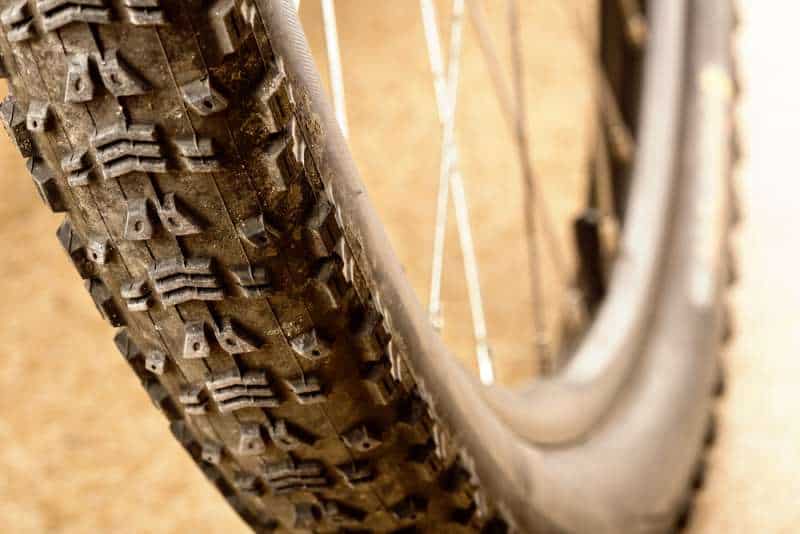Last Updated on March 10, 2022
One of the most common questions mountain bikers asks is how long do mountain bike tires last. The answer depends on many factors such as usage frequency, tire choice, riding style, and many more.
This article answers that question by diving into each mountain bike discipline. We’ll also show the signs you need to replace your tires. And the factors that affect tire lifespan.
This helps you know when to replace your tires so you can avoid flats and accidents. It will also help you have a better and more memorable mountain bike ride.
How long do mountain bike tires last?
It depends. But the average lifespan of mountain bike tires is around 3,000 to 8,000 miles. This is equivalent to around 8 months to 2 years of usage if you’re a weekend rider. But it can last long if you just ride a few times monthly. This also depends on your mountain bike discipline.
There are 3 main types of mountain bikes:
- Cross-country
- Enduro
- Downhill
These three disciplines have different riding styles. And they can affect how long your tires last.
Related: Do Mountain Bike Tires Wear Faster on the Road?
Cross-country Tires Average Lifespan
Cross-country tires last for around 5,000 to 8,000 miles. They last longer than other tire types because they receive little stress and pressure when riding. Cross-country tires are usually ridden on light trails. There are even times when they’re used on asphalt roads.
Using your tires on these terrains means that you have fewer chances of tire damage. Your treads and sidewalls might become thinner. But that’s not a major problem compared to the other tires used for more aggressive trails.
How long do enduro mountain bike tires last?
Enduro mountain bike tires are more aggressive than cross-country tires. They are used on light to technical downhill trails. And the chances of tire damage and punctures are higher because you’ll ride through jagged rocks.
This is why enduro mountain bike tires don’t last as long as cross-country ones. They last for around 4,000 to 6,000 miles or even less. But they last far longer than downhill tires, which receive the worst stress.
When do you need to replace downhill mountain bike tires?
Downhill mountain bike tires have the shortest lifespan because they are ridden on aggressive downhill trails. They usually get ripped, have punctures, or get thin fast because of the hardcore riding style.
This is why they last for around 2,000 to 4,000 miles at most or even shorter. There are even times when they’re just used for a maximum of three months or around 4 to 6 months.
This is because professional downhill riders prioritize grip and traction. And they can only achieve these with new downhill tires.
Top Signs You Need to Replace Your Mountain Bike Tire
Thin knobs
The first sign that you need to replace your tire is thin knobs. Knobs are the treads found on the upper sides of your tires. They provide grip and give you traction so you don’t slide on trails. You must have a good grip on your tires so you can ride safely and fast.
Thin knobs are dangerous for mountain biking because you can easily lose control. You can also slide and lose traction, then crash on hard rocks. You surely don’t want to experience that, right? Well, you can avoid that by getting new tires that have thick knobs.
Faded lettering
Tires with faded lettering don’t pose any immediate threat to your riding. But they show that your tires already went through lots of beating. Faded lettering also means that you’ve used your tires hard enough that it loses its aesthetic value.
This can mean that its internal sections underwent lots of stress that you need to replace them soon.
Failing to consider this can create more serious tire damages such as punctures and ripped sidewalls. You should get stock replacement tires as early as now, even though you’ve just seen faded lettering.
Punctures
Punctured tires are dangerous to ride, even if they’re tubeless-ready. You might think that this is alright because the sealant sealed the punctures correctly. Well, that’s true.
But there’s a good chance that those sealed punctures will reopen. And reopened punctures can lead to bigger punctures. It can even rip off your tires entirely and spill out all those sealants. That is a colossal waste, especially since that mountain bike tire sealant is expensive.
Sidewall scars
Sidewall scars might seem like minor tire issues. But they can get bigger if left unattended. This is true, especially that sidewalls are the thinnest part of your tire. There’s a high chance that a jagged rock or rough root can punch a hole through the scar.
We recommend you replace your tire as soon as you find scars on its sidewalls. This comes in different forms. But they usually take the shape of small and simple lines. There are also times when sidewall scars can dent your rims if it hits something sharp.
Wobbly
Wobbly tires also mean that it needs replacement. This is a sign that the tire’s overall structure isn’t as solid as before. Having wobbly tires also means that your wheels aren’t any more aligned.
And you’ll have a hard time maneuvering through technical terrain with wheels that turn on their own. You might not easily recognize the changes, but you will after a few rides. It’s important to prioritize your riding comfort and maneuverability so you don’t get into an accident.
Factors Affecting Your Tires’ Lifespan

Tire quality
Tire quality is the biggest factor that affects lifespan. There are different tires made for a specific discipline. Take, for example, the Maxxis Assegai which is built for maximum durability and reliability on very rough trails.
This has a DH casing feature which gives additional protection on its treads and sidewalls against sharp rocks. This means that it can better protect your tires from punctures compared to other tire types.
Terrain
The terrain you ride has a huge effect on your tire’s lifespan. Using downhill tires like Maxxis DHR, DHF II, and High Roller on paved roads means that your tires will easily shred.
They aren’t made for paved roads because their compounds are built to deal with softer terrain like trails and mud. Meanwhile, using light trail tires like Onza Porcupine and Maxxis Ardent on downhill trails results in a shorter tire lifespan.
Frequency of usage
Your mountain bike tires will shed more rubber, the more you use them. So expect to replace your tires faster if you always use them.
Riding style
Riding style also has a big effect on your tires’ lifespan. Your tire rubber will easily shred and lose its tread if you always skid.
Constant braking on downhill trails can also cause premature wear on your tires. Your front and rear tires can also get ripped if you don’t choose lines, and you just hurdle your way through any road or trail line.
Conclusion
Knowing how long do mountain bike tires last is important so you can prepare ahead of time. You surely don’t want to find your tires ripped while you’re deep in the trails.
Mountain biking is all about preparation and knowledge. You need to have these two things for you to have a more enjoyable time riding your bike.
Hopefully, this article helped you know how long do mountain bike tires last. Just make sure you choose the right tire that fits your riding style. Also, consider the trails you’ll ride on.
When you do, then you’ll surely enjoy the trails more with your mountain bike.
Related:
Best Mountain Bike Tires for Road Use
